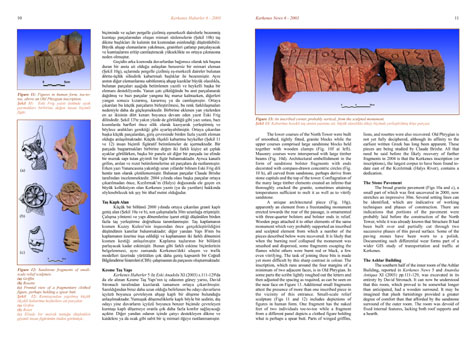THE
PALACE COMPLEX
The
Monumental Entrance
Excavation
of the northern half of the monumental entrance to the Palace
Complex (Fig. 10) showed that the wide stone-paved passage was
covered by a substantial pitched roof covered with reed thatch.
A square sandstone post base with a circular recess to retain
a wooden column 1.00m in diameter (Fig. 10e)
might have supported the northern side of this roof. The pediment
may have been adorned by the pair of bronze ibex, shown on the
cover of Kerkenes News 5, perhaps flanking a sacred tree. There
appear to have been wooden doors strengthened with long iron
bands affixed with big dome-headed nails, while iron brackets
strengthened or joined other architectural timbers (Fig. 10f
at right).
The lower courses
of the North Tower were built of smoothed, tightly fitted, granite
blocks while the upper courses comprised large sandstone blocks
held together with wooden clamps (Fig. 10f
at left). Masonry courses were interspersed with large timber
beams (Fig. 10d). Architectural
embellishment in the form of sandstone bolster fragments with
ends decorated with compass-drawn concentric circles (Fig. 10h),
all carved from sandstone, perhaps derive from stone capitals
and the top of the tower. Conflagration of the many large timber
elements created an inferno that thoroughly cracked the granite,
sometimes attaining temperatures sufficient to melt it as well
as to vitrify sandstone.
A unique architectural
piece (Fig. 10g),
apparently an element from a freestanding monument
erected towards the rear of the passage, is ornamented with
three-quarter bolsters and bolster ends in relief. Wooden pegs
attached it to other elements of the same monument which very
probably supported an inscribed and sculpted element from which
a number of the pieces described below were recovered. It is
likely that when the burning roof collapsed the monument was
smashed and dispersed, some fragments escaping the flames whilst
others were burnt red or black, a few even vitrifying. The task
of joining these bits is made yet more difficult by this sharp
contrast in colour. The inscription, which runs around the four
margins of a minimum of two adjacent faces, is in Old Phrygian.
In some parts the scribe lightly roughed out the letters and
then adjusted the spacing as required, as can be seen on the
near face on Figure 13.
Additional small fragments attest the presence of more than
one inscribed piece in the vicinity of this entrance. Small-scale
relief sculpture (Figs 11
and 12) includes depictions
of figures in human form. One fragment has the naked feet of
two individuals toe-to-toe while a fragment from a different
panel depicts a clothed figure holding what is perhaps a spear
butt. Parts of winged griffins, lions, and rosettes were also
recovered. Old Phrygian is not yet fully deciphered, although
its affinity to the earliest written Greek has long been apparent.
These pieces are being studied by Claude Brixhe. All that need
be said before the likely recovery of further fragments in 2004
is that the Kerkenes inscription (or inscriptions), the largest
corpus to have been found todate east of the Kýzýlýrmak
(Halys River), contains a dedication.
The Stone
Pavement
The broad
granite pavement (Figs 10a and 10c),
a small part of which was first uncovered in 2000, now stretches
an impressive 30m. Several setting lines can be identified,
which are indicative of working techniques and phases of construction.
There are indications that portions of the pavement were probably
laid before the construction of the North Tower, while it was
already known that Structure B had been built over and partially
cut through two successive phases of this paved surface. Some
of the paving stones have been worn to a polish. Documenting
such differential wear forms part of a wider GIS study of transportation
and traffic at Kerkenes.
The Ashlar Building
The southern
half of the inner room of the Ashlar Building, reported in Kerkenes
News 5 and Anatolia Antiqua XI (2003) pp.111-129, was excavated
in its entirety by David Stronach. It can now be understood
that this room, which proved to be somewhat longer than anticipated,
had a wooden surround. It may be imagined that plush furnishings
provided a greater degree of comfort than that afforded by the
sandstone surround of the outer room. The room was devoid of
fixed internal features, lacking both roof supports and a hearth.



